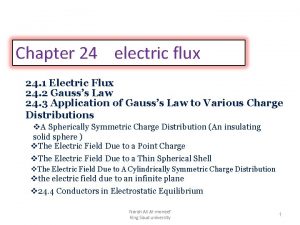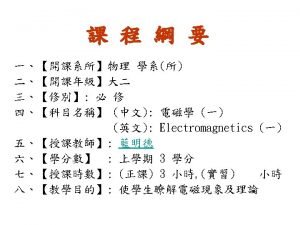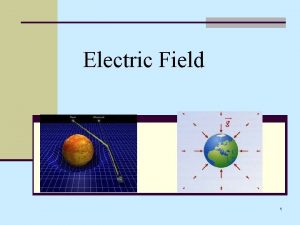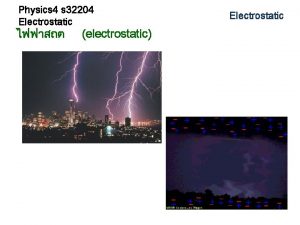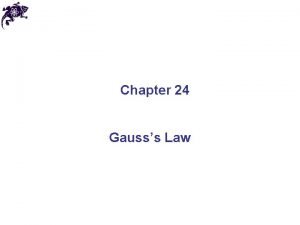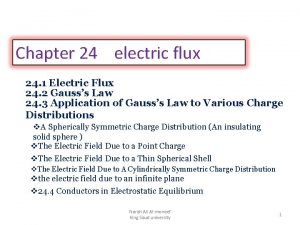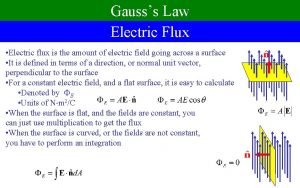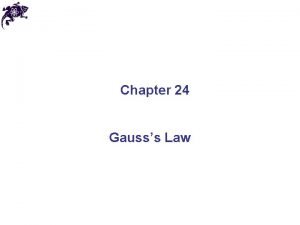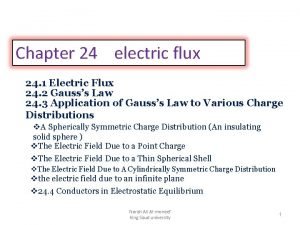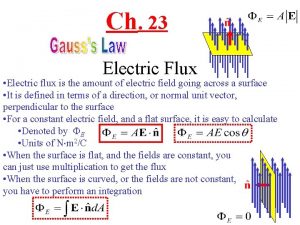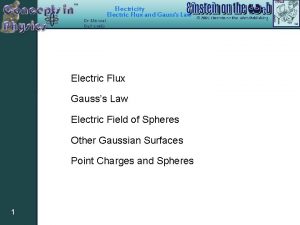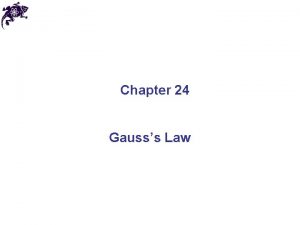ELECTROMAGNETICS THEORY SEE 2523 ELECTROSTATIC FIELD ELECTRIC FLUX















- Slides: 15

ELECTROMAGNETICS THEORY (SEE 2523) ELECTROSTATIC FIELD

ELECTRIC FLUX DENSITY, GAUSS’S LAW & DIVERGENCE THEOREM

INTRODUCTION ¨ Gauss’s law is used to find electric flux intensity. ¨ Using Gauss’s law the work turns out to be easier but it only convenient for symmetrical charges distribution. ¨ Electric flux density, any charge distribution. gives a total flux lines obtained by

3. 1: ELECTRIC FLUX ¨ Electric flux is the number of electric field lines penetrating a surface or an area. ¨ The lines of the electric flux emanate from +Q and terminates on –Q. ¨ The lines of the electric flux is in same direction with electric field, . ¨ In SI unit, is used to represent the flux lines, (1)

¨ Consider two point charges, +Q and –Q as shown in Fig. 3. 1

3. 2: ELECTRIC FLUX DENSITY ¨ Defined as total electric flux lines emit from a surface (2) ¨ The electric flux density, with is a vector in same direction , as shown in Fig. 3. 2. The flux lines directly perpendicular to the surface Δs. Fig. 3. 2

¨ From (2) (3) ¨ Consider a point charge Q is located at the origin in a free space. Assume a sphere with a radius, r centered at the origin shown in Fig. 3. 3 (4) V/m (5) Fig. 3. 3 ¨ From (4) & (5): C/m 2 (6)

3. 3: GAUSS’S LAW ¨ Consider the charge distribution, Q surrounded by a closed surface in Fig. 3. 4. ¨ From the concept of the electric flux , then (7) S Fig. 3. 4

Gauss’s law states that the total electric flux through any closed surface is equal to the total charge enclosed by that surface S (8) Fig. 3. 4

¨ If the surface consist of ρv, then : ¨ This law is true for symmetrical charge distributions only.

3. 4 DIVERGENCE ¨ Consider a vector in a coordinate system as shown in Fig. 3. 5

¨ In order to compute the total flux out of this volume, we need to do the surface integral at all the 6 surfaces : ¨The results computed to yield :

¨ Let the volume dv approach zero then applied Gauss’s law. => First Maxwell’s equation for Electrostatics field The net outward flux from a closed surface as the volume shrinks to zero.

(a) (b) (c) Fig. 3. 6 (a) positive divergence (b) negative divergence (c) zero divergence Divergence is applied with vector quantity but yield a scalar result.

3. 5: DIVERGENCE THEOREM ¨ Starting with the Gauss’s law : and Using Hence : The divergence theorem states that the total outward flux of a vector field through the closed surface is the same as the volume integral of the divergence.
 What is electric flux
What is electric flux Cheng field and wave electromagnetics
Cheng field and wave electromagnetics Energy and electric field
Energy and electric field Potential difference
Potential difference Electrical potential energy
Electrical potential energy Electric field and electric potential
Electric field and electric potential Chapter 21 electric charge and electric field
Chapter 21 electric charge and electric field Chapter 21 electric charge and electric field
Chapter 21 electric charge and electric field Coulombs units
Coulombs units Dc o/d per item charge
Dc o/d per item charge Image theory electromagnetics
Image theory electromagnetics 21lwuy8i6hw -site:youtube.com
21lwuy8i6hw -site:youtube.com Q factor of capacitor
Q factor of capacitor Difference between electric field and magnetic field
Difference between electric field and magnetic field Difference between magnetic flux and magnetic flux density
Difference between magnetic flux and magnetic flux density Magnetic field density
Magnetic field density
